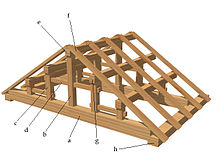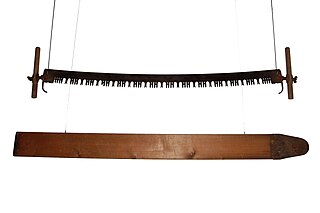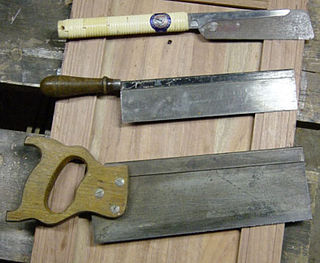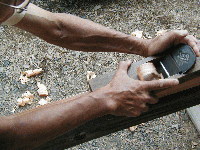

Japanese carpentry was developed more than a millennium ago that is known for its ability to create everything from temples to houses to tea houses to furniture by wood with the use of few nails. [1] [2]


Japanese carpentry was developed more than a millennium ago that is known for its ability to create everything from temples to houses to tea houses to furniture by wood with the use of few nails. [1] [2]
Though there is a core practice shared by all Japanese carpenters, defined by a vocabulary of tools and joints and a method of working, a carpenter will typically identify with one of four distinct carpentry professions. Miyadaiku (宮大工) practice the construction of Japanese shrines and temples, and are renowned for their use of elaborate wooden joints [3] and the fact that the buildings they construct are frequently found among the world's longest surviving wooden structures. Teahouse and residential carpenters, known as sukiya-daiku (数奇屋大工), are famed for their delicate aesthetic constructions using rustic materials. Furniture makers are known as sashimono-shi (指し物師), and interior finishing carpenters, who build shōji (障子) and ranma (欄間), are termed tateguya (建具屋). [4]
Though it is rare to find a sashimono-shi or tateguya practising outside of their field, it is not uncommon for a carpentry workshop to work simultaneously as both miyadaiku and sukiyadaiku.
The tools commonly used by Japanese carpenters are divided into a few basic families, within which there are found a multitude of variations and specializations geared toward particular tasks:




Though a carpenter will typically fashion handles and woodblocks and set and sharpen their blades themselves, the blades themselves are forged by steel smiths and provided unmounted to the carpenter. Japanese steel has long enjoyed a high level of refinement, without which the fine surfaces and detail for which Japanese woodwork is renowned would not be possible. The blades used in the Japanese chisel and the Japanese plane shares similar constructive principles to the Japanese sword. A thin piece of extremely hard blade metal called ha-gane (鋼, lit. 'edge metal') is forge-welded to a softer piece of metal called ji-gane (地金, lit. 'base metal'). The function of the softer base metal is to absorb shock, and to protect the more brittle ha-gane from breaking. This technology allows for the use of steels in the hagane which are harder than in use in Western chisels, typically Rockwell 62 and up, and also allows for the honing of a much finer edge than is typically known in carpentry outside Japan. When sharpening a blade, a Japanese carpenter will typically use three or more whetstones of varying coarseness, progressing from the roughest stone to the finest. [5]
The blades of both planes and chisels are distinguished by the hollow, ura in their flat side. This hollow portion has a number of functions. The primary function is that it ensures a high degree of flatness when sharpening, in that when the flat side is polished it cannot rock or develop a curve because it is only contacting the stone on either side of its width. This then improves the precision with which cuts can be made by the chisel, and in the case of planes ensures smooth contact with the wedge and therefore even support across the full width of its blade. The hollow also greatly reduces the amount of metal needed to be removed to achieve flatness on the back of the blade, which shortens initial set-up and subsequent re-sharpening considerably. Secondly, in the case of chisels, it reduces the frictional resistance as the chisel is driven into or extracted from the wood. Thirdly, the interaction of the leading edge of the hollow with the edge of the blade is a changing relationship as the tool is re-sharpened. [5] With plane blades, as the edge is sharpened down to the rim of the hollow, the edge can then be 'tapped-out' (ura-dashi), a process where a pointed hammer is used to depress the ha-gane downward slightly along the bevel of the blade. When the blade's back is re-flattened after ura-dashi, the hollow is re-established; thus the hollow acts as a sort of gauge for sharpening as a means of prolonging the life of the thin piece of cutting steel as long as possible. This in turn tends to keep the geometry of the blade consistent over time, which keeps it fitting the dai over time.
There are many types of steel used for the ha-gane of Japanese planes and chisels:

The traditional Japanese vise was a wedge of wood tied to a post with a coil of rope. The wood was inserted under the wedge and the wedge hammered down. [5]
Vises of any sort are used far less in traditional Japanese carpentry than would be the case for equivalent tasks in the traditional crafts of the West. Many tasks in Japanese carpentry associated with building, involve very large pieces of timber, and in general, the weight of the timber and of the carpenter are used to stabilize the piece on which the carpenter is working. For this reason the carpenter's horses used in Japan are much lower than their Western counterparts, and carpenters must always position themselves over their work. [5] Much of the work on smaller pieces of material can be done in the seated position, and relies on the fact that the saws and planes both cut on the pull stroke, enabling stabilization of the work using the body or shooting board.
Woods used in Japanese carpentry and woodwork, as well as tool construction, include sugi (杉), akamatsu (赤松), hinoki (檜 or 桧), Camphor Laurel, Magnolia obovata, keyaki (欅) and kiri (桐).

A hammer is a tool, most often a hand tool, consisting of a weighted "head" fixed to a long handle that is swung to deliver an impact to a small area of an object. This can be, for example, to drive nails into wood, to shape metal, or to crush rock. Hammers are used for a wide range of driving, shaping, breaking and non-destructive striking applications. Traditional disciplines include carpentry, blacksmithing, warfare, and percussive musicianship.

In woodworking and carpentry, hand saws, also known as "panel saws", are used to cut pieces of wood into different shapes. This is usually done in order to join the pieces together and carve a wooden object. They usually operate by having a series of sharp points of some substance that is harder than the wood being cut. The hand saw is a bit like a tenon saw, but with one flat, sharp edge.

A chisel is a wedged hand tool with a characteristically shaped cutting edge on the end of its blade, for carving or cutting a hard material. The tool can be used by hand, struck with a mallet, or applied with mechanical power. The handle and blade of some types of chisel are made of metal or wood with a sharp edge in it.
A saw is a tool consisting of a tough blade, wire, or chain with a hard toothed edge used to cut through material. Various terms are used to describe toothed and abrasive saws.

A blade is the sharp, cutting portion of a tool, weapon, or machine, specifically designed to puncture, chop, slice, or scrape surfaces or materials. Blades are typically made from materials that are harder than those they are intended to cut. This includes early examples made from flaked stones like flint or obsidian, evolving through the ages into metal forms like copper, bronze, and iron, and culminating in modern versions made from steel or ceramics. Serving as one of humanity's oldest tools, blades continue to have wide-ranging applications, including in combat, cooking, and various other everyday and specialized tasks.

A hand plane is a tool for shaping wood using muscle power to force the cutting blade over the wood surface. Some rotary power planers are motorized power tools used for the same types of larger tasks, but are unsuitable for fine-scale planing, where a miniature hand plane is used.

A Japanese kitchen knife is a type of kitchen knife used for food preparation. These knives come in many different varieties and are often made using traditional Japanese blacksmithing techniques. They can be made from stainless steel, or hagane, which is the same kind of steel used to make Japanese swords. Most knives are referred to as hōchō or the variation -bōchō in compound words but can have other names including -kiri. There are four general categories used to distinguish the Japanese knife designs: handle, blade grind, steel, and construction.

The Japanese saw or nokogiri (鋸) is a type of saw used in woodworking and Japanese carpentry that cuts on the pull stroke, unlike most European saws that cut on the push stroke. Japanese saws are the best known pull saws, but they are also used in China, Iran, Iraq, Korea, Nepal, and Turkey. Among European saws, both coping saws for woodworking and jeweler's saws for metal working also cut on the pull stroke like Japanese saws. Cutting on the pull stroke is claimed to cut more efficiently and leave a narrower cut width. On the other hand, a pull stroke does not easily permit putting one's body weight behind a stroke. This can be readily solved by using a vice or clamping. Another disadvantage, due to the arrangement and form of the teeth, is that Japanese saws do not work as well on hardwoods as European saws do. Japanese saws were originally intended for comparatively soft woods like cypress and pine whereas European saws were intended for hard woods like oak and maple.

A blade's grind is its cross-sectional shape in a plane normal to the edge. Grind differs from blade profile, which is the blade's cross-sectional shape in the plane containing the blade's edge and the centre contour of the blade's back. The grind of a blade should not be confused with the bevel forming the sharpened edge; it more usually describes the overall cross-section of the blade, not inclusive of the beveled cutting edge which is typically of a different, less acute angle as the bevel ground onto the blade to give it a cross-sectional shape. For example, the famous Buck 110 hunting knife has a "hollow ground" blade, with concave blade faces, but the cutting edge itself is a simple, flat-ground bevel of lesser angle. It would be difficult, if not impossible, to put a "hollow grind" onto the actual cutting edge of the blade itself, which is a very narrow and small bevel.

A mallet is a tool used for imparting force on another object, often made of rubber or sometimes wood, that is smaller than a maul or beetle, and usually has a relatively large head.

A crosscut saw is any saw designed for cutting wood perpendicular to (across) the wood grain. Crosscut saws may be small or large, with small teeth close together for fine work like woodworking or large for coarse work like log bucking, and can be a hand tool or power tool.
A ripsaw is a wood saw that is specially designed for making a rip cut, a cut made parallel to the direction of the wood grain.

A kitchen knife is any knife that is intended to be used in food preparation. While much of this work can be accomplished with a few general-purpose knives – notably a large chef's knife, a tough cleaver, a small paring knife and some sort of serrated blade – there are also many specialized knives that are designed for specific tasks. Kitchen knives can be made from several different materials.

A backsaw is any hand saw which has a stiffening rib on the edge opposite the cutting edge, enabling better control and more precise cutting than with other types of saws. Backsaws are normally used in woodworking for precise work, such as cutting dovetails, mitres, or tenons in cabinetry and joinery. Because of the stiffening rib, backsaws are limited in the depth to which they can cut. Backsaws usually have relatively closely spaced teeth, often with little or no set.

The Japanese plane or kanna (鉋) is a plane pulled towards the user rather than pushed in the manner of western style planes. They are made of hardwood, usually Japanese white or red oak. The laminated steel and iron blade is stout compared to western planes. Tapered in length and thickness, the plane blade is its own wedge, as it fits into a correspondingly-shaped mortice in the body of the plane, thus dispensing the need for a separate wedge to hold the blade in place, as is the case in most other traditional wooden planes. The chip breaker is held in place with a simple nail inserted some distance away from and perpendicular to the axis of the main blade. The chip breaker is not tapered like the main blade; instead, it has bent "ears" that bear down on the plane blade. Chip breakers in Japan were introduced relatively recently, during the Meiji period. The soles of Japanese planes also have different configurations for varying applications. The apparently simple design disguises a great deal of complexity.

Sharpening is the process of creating or refining the edge joining two non-coplanar faces into a converging apex, thereby creating an edge of appropriate shape on a tool or implement designed for cutting. Sharpening is done by removing material on an implement with an abrasive substance harder than the material of the implement, followed sometimes by processes to polish/hone the sharp surface to increase smoothness.

The Woodwright's Shop was an American traditional woodworking show hosted by master carpenter Roy Underhill and airing on television network PBS. It is one of the longest running how-to shows on PBS, with thirty-five 13-episode seasons produced. Since its debut in 1979, the show has aired over 400 episodes. The first two seasons were broadcast only on public TV in North Carolina; the season numbering was restarted when the show went national in 1981. It is filmed at the UNC-TV studios in Research Triangle Park, North Carolina. It is no longer being produced.
This glossary of woodworking lists a number of specialized terms and concepts used in woodworking, carpentry, and related disciplines.

An axe is an implement that has been used for millennia to shape, split, and cut wood, to harvest timber, as a weapon, and as a ceremonial or heraldic symbol. The axe has many forms and specialised uses but generally consists of an axe head with a handle, also called a haft or a helve.
{{cite web}}: CS1 maint: archived copy as title (link)